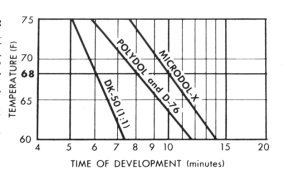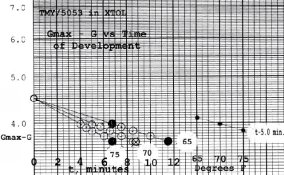The behavior of T-max film in 9 developers at 5 temperatures is given on pages 18 - 19 of the Kodak B&W Darkroom Dataguide and is updated as of fall 2007 as I showed on their web site. It is non-linear and different for each developer.
PE
Yes, I reviewed these charts and it reminded me of the reason I started decoding the charts in the first place. The carts, as they are, have never been much use for temperature compensation for me because the times in the chart are usually never the same times I am using. So, way back then the question for me was "can I somehow use the info in the chart to figure out my time/temp combinations WITHOUT having to do my own time/temp testing?"
Just for clarity; an example:
Lets say the chart clearly shows 7 min at 20C and 8 min at 24C. I let all my chemicals equilibrate to room temp and they measure 24C so I use 8 min. The problem is what if MY time at 20C is NOT 7 min. In fact it is USUALLY the CASE that my time at 20C it is always something different than the chart. Say my time is 6 min. at 20C. Now the question is what do I do when the temp is 24C?? Because the response curve is not linear, it is not such a simple math problem to do in your head.
Now, getting to the Table that was mentioned. I did graph the various developer combos with the T-max 400 film and, except for 1 or 2 exceptions, it looks like they follow a similar curve that is shfted on the temperature axis for each developer. It looked like the combined curve could be modeled with a single exponential function or a third order polynomial.
So, YES, the T-max 400 can be modeled with a single curve for MOST of the developers, BUT there will be some ERROR. For B&W work, that error may not be significant but I WON'T comment on it unless it is tested. (The T-max spreadsheet I posted was created with only the T-Max 400 in T-Max developer data).
So, it MAY be possible to model many film/dev combos with just a few different curves (or pages of a spread sheet) assuming one can accept some error.
Also, as far as I know (and I could be very wrong on this) Kodak does not have a way to 'customize' their time/temp table for YOUR PERSONAL development times. If they did, then much of what I just wrote would be moot.
My personal thoughts on the subject:
1) I think developing film at 'room temp' can work well...
2) If you have a good time/temp chart
3) Manufacturers charts frequently don't have YOUR personal developing time listed
4) It IS possible to model a single film/developer combo on a temperature correction spreadsheet showing YOUR personal developing time, or multiple times (N, N+1 etc).
5) It MAY be possible to for someone to collect data to model a number of film/developer combos with just a few different equations.




